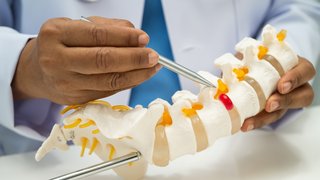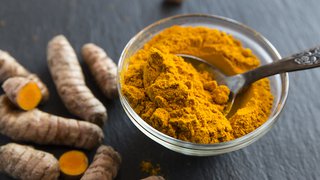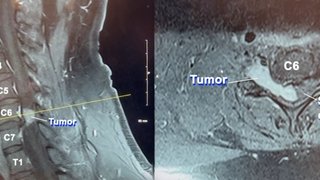Get help for back, neck, and leg pain caused by spinal stenosis
March 26, 2025

Too many people live with unnecessary pain related to spinal conditions. One of the most common ones UT Southwestern treats is spinal stenosis, in which the spinal canal narrows and puts pressure on the spinal cord and nerves.
Normal wear and tear as we age causes our spines to change. The American Academy of Orthopedic Surgeons says up to 95 percent of people 50 or older experience degenerative changes of the spine, and spinal stenosis can affect 8 to 11 percent of them.
Spinal stenosis symptoms can be managed and treated. This doesn’t always mean surgery, but if you do need surgery, know there are minimally invasive options that can make recovery a little easier than in the past. Let’s talk about what causes spinal stenosis, its symptoms, and how we can treat it.
What is spinal stenosis?
The spinal canal is the space through which the spinal cord passes. When this space narrows, it can put pressure on the spinal cord and nerves and cause pain.
There are several types of spinal stenosis, and they relate to where along the spine the narrowing occurs:
- Cervical spinal stenosis, which occurs in the neck
- Thoracic stenosis, which occurs in the mid-back
- Lumbar stenosis, which occurs in the lower back
Spinal stenosis can develop at any age, but it’s most common among people 50 and older. Some of the most common causes of spinal stenosis include:
- Aging: As noted earlier, the spine changes as we age. The ligaments become thicker or the bones and joints get bigger, resulting in a narrower spinal canal.
- Arthritis: Vertebrae, or the bones that form the spine, can begin to compress and wear against the joints that allow it to flex after years of repetitive motion. This can cause the joints to deteriorate, resulting in inflammation or the development of bone spurs, which are bony projections that form on the surface of bones.
- Congenital defect: Some people are born with a small spinal canal. This is the most common type of spinal stenosis found in young people. It might present in teens who play contact sports and experience recurring numbness or weakness in their hands, or what we call “stingers,” which are pinched nerve injuries.
- Spinal deformities: Spinal conditions such as scoliosis, in which there is a curvature of the spine, or spondylolisthesis, in which a vertebrae moves out of position onto the vertebra below it, can cause the spinal canal to narrow.
Symptoms of spinal stenosis
Spinal stenosis is a degenerative disease, which means it gets worse over time. It starts slowly, and by the time you notice pain, it’s probably been brewing for some time.
Nerves relay sensation to specific parts of the body. Pressure on these nerves can cause pain, tingling, or numbness in those body parts. Common symptoms include:
If you are experiencing any of these symptoms, request an appointment to talk to a doctor about whether you may have spinal stenosis or another spinal condition.
Diagnosis of spinal stenosis starts with discussing your medical history and symptoms. If we suspect spinal stenosis, we’ll likely get high-resolution imaging such as a magnetic resonance imaging (MRI) or computerized tomography (CT) scan. Once we confirm it’s spinal stenosis, we can discuss treatment options.
- Pain in the neck or back
- Pain that radiates down into the legs
- Tingling, numbness, or weakness in the arms, legs, or buttocks
- Muscle atrophy or motor loss in extreme cases
How we treat spinal stenosis
There isn’t one “right” treatment for spinal stenosis. What works for one person may not work for another.
We always try to start with the most conservative methods, such as:
These treatments work for the vast majority of spinal stenosis patients, with only a small percentage needing surgery. Remember, spinal stenosis is a degenerative disease, and these methods are most effective at the early stage, underscoring the importance of early diagnosis and treatment.
If these methods don’t bring pain relief, you may need surgery to make more room for the spinal cord and nerves in the spinal canal. I know many people are scared by the thought of back surgery, but these aren’t the surgeries of years past. We offer a number of minimally invasive options, which require smaller incisions and a shorter recovery period, allowing you to more quickly get back to daily activities.
You and your doctor will examine the best options for your situation. If you don’t feel comfortable, get a second opinion. You shouldn’t have to live with back pain or tingling, numbness, or weakness in your arms and legs. Talk with your doctor to find the cause of your pain and to begin a treatment plan.
- Anti-inflammatories or muscle relaxants
- Cortisone injections
- Physical therapy










